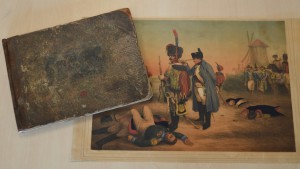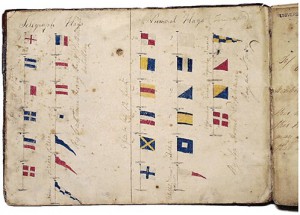This spring one of the treasures of our Archives and Special Collections is setting off on a journey to Paris where it will feature in a major new exhibition on the life of the Emperor Napoleon. The volume is a British military signal book which contained detailed instructions for the garrison guarding Napoleon during his exile on the island of St Helena.
The signal book is a well-travelled volume. It was first used by Colonel Mark Wilks, Governor General of St Helena in 1815. This piece of Napoleonic memorabilia passed through the hands of a number of collectors until it was purchased at auction in New York by the family of Burt Eddy Taylor in 1928. In 1969 Mr Taylor donated his collection of Napoleonic material, including the signal book, to the new university library at Stirling. Now, in 2016 it sets sail again, for the Musée de l’Armée in Paris.

The signal book will feature in Napoléon à Sainte-Hélène. La Conquête de la Mémoire, a major new exhibition looking at Napoleon’s period of exile on the mid-Atlantic island which opens on 6 April 2016. Our small, scruffy volume will take its place alongside an extensive range of items from collections across Europe which have been brought together to tell the story of Napoleon’s captivity on St Helena.

The signal book highlights the lengths the to which the British went to ensure Napoleon did not escape from the island. The inside covers illustrate the flags and signals which were to be used for communication including those for raising the alarm if Napoleon was missing. To limit the chance of rescue by his supporters a garrison of 1,300 troops was placed on the tiny island. In addition four Royal Navy ships patrolled offshore. Within the pages of the book further detailed instructions were laid out in the event of Napoleon’s absence:
‘the Signal Officers of the different posts are strictly enjoined to lose no time in communicating the intelligence personally to the places nearest them where troops may be stationed to the end that patroles may be immediately sent out in every direction to insure the impracticability of any person escaping from the island.’
The procedures put in place evidently worked. Napoleon remained on the island until his death in May 1821.
Napoléon à Sainte-Hélène. La Conquête de la Mémoire
Musée de l’Armée, Paris
6th April – 24th July 2016